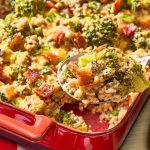“Are there rules?” says one Southern Living reader. Our answer: If you want your baked goods to turn out right, then yes!
We asked, “Which cooking or baking rule do you always break?” and the answers weren’t too surprising. There was certainly a wide array of comments including many people who admitted to simply just not following recipes and others who emphasized always using salted over unsalted butter.
One reader said, “I never follow a recipe exactly, I always use more vanilla and an extra egg, and I often don’t preheat the oven,” which sums up a majority of the 248 comments. After sifting through all of them so you didn’t have to, these are the five most common baking rules our readers love to ignore. Some we can get behind, but others are definite no-nos. (And the Test Kitchen pros would likely say many are the culprit of your dry or sunken cake and crumbly cookies.)
Using Exact Measurements
What measuring cups? When it comes to vanilla, cinnamon, or chocolate chips you won’t find Southerners with a teaspoon in hand. Rather they prefer the eyeball method. “I measure ingredients the Southern way…to suit my taste,” says one reader. “I always use more vanilla and cinnamon than the recipe calls for.” We can agree with this one…most of the time!
It might not be written in recipe books, but if you’re looking at Mama’s handwritten recipe card chances are it says “dash”, “smidge”, or “pinch” in lieu of precise measurements. One reader says, “Cinnamon and vanilla, who measures? You can’t get too much!” while another adds: “If it looks about right, dump it in.” Many note, the same measuring philosophy applies to garlic, cheese, salt, and pepper.
Frederick Hardy II; Food Styling: Chelsea Zimmer; Prop Styling: Mat Gibilisco
Preheating the Oven
Apparently, a lot of our Southern bakers skip preheating your oven!? “I put whatever I’m baking in and watch it,” says one reader. Another adds: “I put [the] goods in a cold oven, set temperature, set timer for designated time and leave. Staying in a warm oven after [the] timer turns off, apparently compensates for not preheating.”
While there are some recipes that specifically call for starting a cast iron skillet or dish—like our Cold-Oven Black Walnut Cake—in a cold oven, we don’t recommend skipping this step otherwise. Preheating the oven is important for even cooking. It might not matter as much for a sheet pan of veggies, but for any baked good or egg-heavy recipe, not doing so can especially impact the dish’s rise. It’s easy to crank the oven on while you’re prepping your dish and will help it cook properly and faster.
Using the Right Measuring Cups
When the recipe calls for oil or milk are you using a liquid measuring cup? “I never use certain measuring cups for wet or dry ingredients. To me they measure the same,” says a Southern Living reader.
While many don’t think so, or choose to ignore it as do many of our readers, there is in fact a difference between liquid and dry measuring tools. Each is specifically designed to measure their respective type of ingredient—wet or dry.
Unless you’re using a kitchen scale, sticking to the proper measuring tools is important for accurate measurements of each ingredient called for by the written and tested recipe—the only exception is Grandma’s recipes. Follow her lead!
On the wet vs. dry topic, readers also confess to rarely using separate bowls when called for. “I never use separate bowls for dry and wet ingredients. So stupid! I cream butter and sugar first and then add everything all at once,” says one reader. Sure, you can get away with this sometimes—and we know dirtying up an extra dish is never fun—but it’s also important to properly incorporate everything. No one wants flour lumps in their cake!
Leveling (And Sifting) Flour
There were too many comments in the vein of “I don’t bother sifting or leveling flour” to count. One reader said, “I never level the flour in the measuring cup before pouring it in my bowl,” while another admits “I’m an anti-sifter.”
If you’ve ever followed a recipe to a T and your cake or cookies still came out wrong, the culprit is likely your flour measuring technique. Digging your measuring cup into the bag of flour and dumping it in your bowl is not the way to go. Always use a spoon to scoop the flour into your measuring cup, then level it off with a knife or spatula for the most accurate measurement. And if you’re adamantly against the spoon-and-level method, consider weighing your ingredients instead.
As for sifting, you certainly don’t always need to sift your flour, but if the recipe (like Chiffon Cake or Angel Food Cake) specifically calls for it, I’d heed the advice. Sifting a dry ingredient before measuring it not only helps break up and clumps, but helps the measurement to be more accurate and leads to a lighter, airier end product.
Sticking to How Many Eggs the Recipe Calls For
I was genuinely shocked by how many readers said they always add an extra egg. One noted, “I always add an extra egg when it only calls for two,” and another said they “Never measure vanilla extract and always add an extra egg.”
Some say this helps make your cake fluffier and rise better. Sometimes adding an extra egg is okay, but most of the time it’s not the best idea. Unless you only have tiny eggs and the recipe calls for two large ones so you add a third to make up for the difference, then maybe we can get behind breaking this rule. Otherwise stick to the recipe as it’s written.








